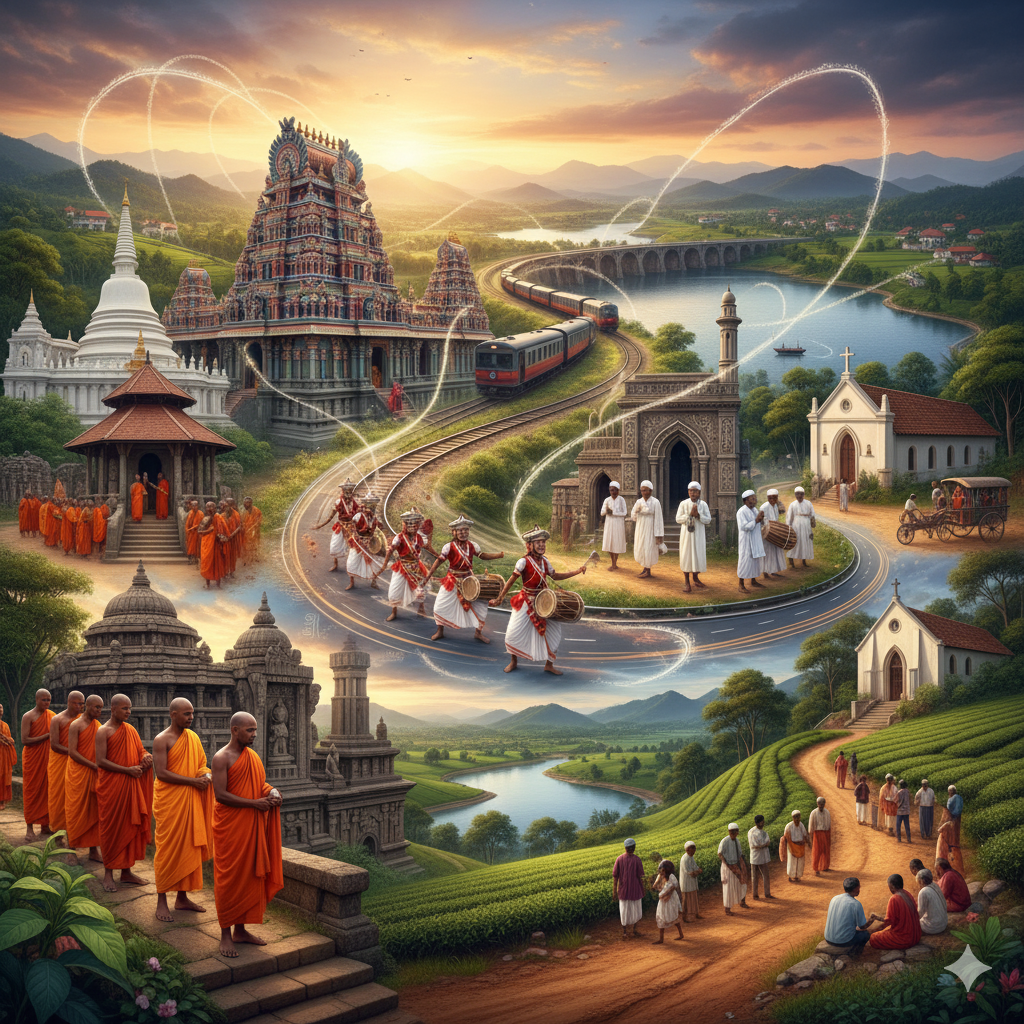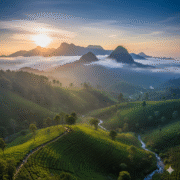
Sri Lanka’s Cultural Tapestry: A Story of Connections and Shared Heritage
- November 12, 2025
- eunoialankatours
- 6:18 pm
Sri Lanka’s position at the intersection of the Indian Ocean sea-lanes has always made the island a meeting point of peoples and ideas. For more than two millennia traders, monks and emissaries have moved across its shores, leaving behind a legacy that still colours life in the island’s temples, languages and rituals. The ancient chronicle Mahāvaṃsa and a wealth of foreign records show that Sri Lanka was not an isolated kingdom but an active participant in regional networks of religion and commerce. What follows is a human-centred journey through some of the most significant cultural relationships that shaped our island’s identity.
Ancient ties with India
Proximity to India was destiny. Professor W. I. Siriweera notes that Sri Lanka’s location encouraged trade relations with the sub-continent long before the island had contact with any other country. Early settlers from northern India crossed the Palk Strait during the first millennium B.C.; genetic memory of this movement survives in the Sinhalese, many of whom descend from Indo-Aryan settlers. Tamil communities trace their ancestry to Dravidian groups who migrated from south India. These connections ensured that the island’s language, food and family names still bear Indian echoes.
The most profound exchange came in the 3rd century B.C. when Emperor Ashoka’s son and daughter, Mahinda and Sangamitta, arrived from India. They introduced Buddhism to Sri Lanka, established an order of monks and nuns, and brought a sapling of the sacred Bo tree from Bodhgaya. This event ushered in a new era: the island’s writing, art, literature and architecture blossomed under Buddhist patronage. Nearly every village temple still tends a descendant of that original Bo sapling, and annual processions celebrate the living tree’s journey from India.
Relics travelled too. The sacred tooth relic, said to be one of the Buddha’s surviving teeth, was brought from India in the 4th century A.D. by Princess Hemamala. Housing this relic conferred legitimacy on kingship; wars were fought over its custody, and the ornate Temple of the Tooth in Kandy remains a pilgrimage site today. Trade, dynastic marriages and occasional invasions kept India and Sri Lanka entwined. Even Hindu deities crossed the strait; the war god Skanda (Kataragama) became a beloved guardian of the Sinhalese, reflecting centuries of shared devotion.
China – a maritime friendship
Sri Lanka looked east as well. Literary records in China and Sri Lanka describe a mission from the Han court (1–6 A.D.) to the island. The kings of Anuradhapura dispatched thirteen embassies to China between 131 A.D. and 989 A.D., sometimes bearing jade statues or models of the Sacred Tooth Relic shrine. Chinese texts record that the Sri Lankan mission of 428 A.D. presented a jade Buddha five feet high; in return, Emperor Ping sent his own envoys.
Archaeologists have unearthed Chinese coins and ceramics at Anuradhapura, Polonnaruwa and Mantai, confirming vigorous trade from the Tang through the Sung dynasties.
These exchanges were not purely material. The island helped to shape the spiritual landscape of East Asia. In the 5th century Sri Lankan bhikkhunīs (Buddhist nuns) travelled to China and introduced the Bhikkhunī sangha (nuns’ order), ensuring that women could receive full ordination. Chinese monks such as the pilgrim Fa-Hsien visited Sri Lanka to study texts and rituals, while scholar-monks like Amoghavajra later carried Sri Lankan tantric texts to China, Korea and Japan. These journeys created a trans-Asian monastic community bound by Pali scripture, ritual practice and personal friendship.
During the Ming period Admiral Zheng He’s treasure fleets put in at Sri Lankan ports. Between 1416 and 1459 his expeditions exchanged ambassadors with Sri Lankan kings. A trilingual inscription in Chinese, Persian and Tamil, erected at Galle, commemorates these visits and symbolises how the island sat at the crossroads of multiple civilizations.
Myanmar and Thailand – Theravada kinship
Myanmar
Relations with Myanmar are rooted in shared faith. The Sāsanavaṃsa, a Burmese chronicle, recounts that Shin Arahan, an 11th-century monk from Thaton, introduced orthodox Theravada Buddhism to King Anawrahta of Bagan after studying in Sri Lanka. Other chronicles claim that Arahan actually hailed from Sri Lanka, underscoring the continuous circulation of monks between the two kingdoms. King Vijayabahu I of Polonnaruwa sent a copy of the Tripitaka to Anawrahta, and Burmese monks studied scripture using the Sinhala script. The relationship deepened when Burmese kings sent monks to Sri Lanka for re-ordination in the 15th century and again in the 18th century. These efforts revitalised the monastic lineage in both countries and led to the formation of the Amarapura Nikaya.
As Buddhism in India waned, Sri Lanka and Myanmar became Theravada strongholds. Roar Media notes that scholars and teachers from Sri Lanka visited Myanmar from the 11th century onwards, and that the city of Bagan contains nearly 260 stupas built in the Sinhalese style. The bell-shaped stupas of Bagan mirror those at Sri Lankan sites like Ruwanweliseya; they stand as stone testimonies to a friendship forged through religion and art.
Thailand
Thailand’s connection with Sri Lanka spans more than eight centuries. Elite Plus Magazine highlights that Theravada Buddhism arrived in Thailand from Sri Lanka over 800 years. Known as Lankavamsa, this form of Buddhism shaped Thai ritual life and royal ideology. In 1753, when Buddhism in colonial Ceylon suffered under Portuguese and Dutch rule, King Borommakot of Ayutthaya sent an eminent monk, Upali Thera, to Sri Lanka to restore higher ordination. The mission re-established the ordination lineage and symbolised how Thailand repaid an ancient spiritual debt. Today Sri Lankan and Thai monks continue to exchange relics, ordinations and scholarships; branches of the sacred Bo tree grow at Thai temples, and Thai monarchs venerate Sri Lanka’s sacred tooth relic.
Sri Lanka’s influence reached even further across Southeast Asia. 13th- and 14th-century Thai kings prized Sinhalese Buddha images and fought wars over the Sihinga statue sent by King Parakramabahu II. Branches of the Bodhi tree were planted with royal veneration in Sukhothai. These stories show how cultural diplomacy in pre-modern Asia often travelled through sacred art and living plants.
West Asia and the wider world
Sri Lanka’s maritime openness extended to West Asia and Europe. Persian merchants established settlements on the island by the 6th century A.D.; Egyptian monk Cosmas Indicopleustes wrote that there was “a church of Persian Christians” in Sri Lanka with clergy appointed from Persia. Roar Media notes that Persian settlements left evidence in the form of a church and a presbyter. These communities likely served the growing trade in spices and gems between the Middle East and China, using Sri Lankan ports as entrepôts.
Arab traders succeeded the Persians. Historical records show that in the 13th and 14th centuries they controlled trade at Colombo, Beruwala, Kalpitiya, Chilaw and Weligama. Archaeologists have discovered gold and silver coins from Baghdad and Alexandria in Sri Lanka. Even artistic styles travelled westward: some historians believe the colossal standing Buddhas of Anuradhapura were inspired by the Bamiyan statues of Afghanistan.
Sri Lanka also reached out to Rome. According to the Sri Lankan embassy in Rome, historian Pliny recorded that four ambassadors from King Yasalalakattissa visited Emperor Claudius around 50 A.D., and another delegation met Emperor Julian in the 4th century. Coins and artefacts unearthed at Anuradhapura and Polonnaruwa confirm early contacts. These missions reveal that even at the fringes of the Roman world, the island’s rulers sought recognition and exchange.
A summary of cultural connections
| Region / country | Key cultural links (keywords & phrases) | Notable periods |
|---|---|---|
| India | Trade & migration; introduction of Buddhism; Bhikkhuni and Bhikkhu orders; sacred Bo sapling & tooth relic | 3rd century B.C. onward |
| China | Diplomatic missions; exchange of relics; Bhikkhuni order introduced; Chinese coins & ceramics; Admiral Zheng He’s voyages | 1st century A.D. – 15th century |
| Myanmar | Theravada transmission; Sinhalese monks re-ordain Burmese clergy; Tripitaka sent to Bagan; Sinhalese-style stupas | 11th – 18th centuries |
| Thailand | Lankavamsa Buddhism; exchange of relics; Upali Thera’s mission to restore ordination; Bodhi tree saplings | 13th century onward |
| West Asia / Persia | Persian Christian church; trade settlements; gold & silver coins; Bamiyan influence on art | 6th – 14th centuries |
| Rome / West | Embassies to Claudius & Julian; Roman coins and artefacts in Sri Lanka | 1st – 4th centuries |
Weaving the threads
Viewed together, these stories reveal an island constantly in conversation with its neighbours. Sri Lankans did not passively receive foreign ideas; they adapted and re-exported them. Indian monks brought the Dhamma, but Sri Lankan nuns carried the female ordination lineage back to China. Myanmar kings sought Sri Lankan ordination, while Thai kings restored that ordination when Sri Lanka needed help. Persian Christians prayed on our soil and our ambassadors bowed before Roman emperors. Chinese ceramics, Arab coins and Sinhalese stupas in foreign lands remind us that Sri Lanka has always been more than the sum of its shores.
Today’s cultural diplomacy and tourism continue these exchanges. Pilgrims still travel between Sri Lanka and India, monks between Sri Lanka and Myanmar, and scholars between Colombo and Beijing. Modern trade agreements with Thailand and Italy reflect age-old goodwill. In an age of globalisation, remembering this history encourages us to value openness and mutual respect. Our island’s cultural tapestry is woven from threads of many colours; honouring each thread enriches the whole.


